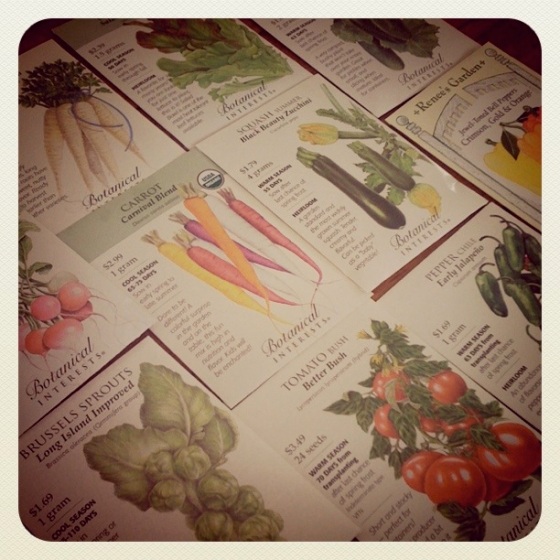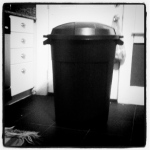Another beautiful Saturday and we couldn’t stand to stay inside. We also happened to run out of coffee so instead of just going to the store to buy new beans, we went out for breakfast. Yay!
Since we were already out and since we hadn’t purchased any seeds yet, we decided to visit the coolest hardware store on the planet, Blackhawk Hardware (I didn’t get paid to say that, I just love the store). It’s probably not the cheapest place, but at least it’s locally owned with friendly, helpful workers who can point lost puppies in the right direction. Plus, they carry lots of heirloom varieties and no GMO seeds.

Upon reaching the seed aisle, after the fast-panting and tail-wagging subsided, we looked at all the vegetable seeds and chose the ones that would work best for us. I really wanted to buy the weirdest stuff like kohlrabi, amaranth, bok choy, and multi-colored beans but I was convinced to stick with what we actually eat the most often. Sigh, it’s good advice but not nearly as fun.
Here’s what we ended up with:
PEPPER chile, Early Jalapeno, Capsicum annuum
We buy jalapenos all the time for use in soups, salsa, and guacamole and we always have to buy too many at Trader Joe’s. We’ll probably just have one plant and use the leftovers to make hot pepper jelly to eat with cheese and crackers. Mmm.
TOMATO bush, Better Bush, Lycopersicon lycopersicum (hybrid)
This was a no-brainer. Everyone knows that tomatoes from the store are just gross. They’ve been genetically modified to withstand long bumpy rides across the country and to be the same size (huge) and same color (orangey red). I’ll probably sneak back to the store and buy three more varieties because I like tomatoes so much.
RADISH, Easter Egg Blend, Raphanus sativus
Totally succumbed to the drawing of purple, white, pink and red radishes on the packet. Radishes with a little bit of salt are like heaven to me. These will be eaten as a snack at work every day that they are available.
PEPPER bell, Jewel-Toned Bell Peppers
Bell peppers cost $4 each at Harris Teeter. Nuff said.
LETTUCE leaf, Salad Bowl Blend, Lactuca sativa
The lettuce we buy always gets slimy before we have a chance to eat it all. I hope this will particular mix will work as a cut and come again plant so we have lettuce all season long!

CARROT, Carnival Blend, Daucus carota sativus
Again, the yellow, pink, white, purple and orange carrots on the packet made me do it. I’m not sure how well these will do in a container but I’m willing to give it a whirl for pink and purple carrots.
CUCUMBER, Spacemaster, Cucumis sativus
“Spacemaster is the solution!” I will keep my cukes in their own container so they don’t overrun my garden and harvest small guys to make pickles and eat the others raw with my radish snack.
SQUASH Summer, Black Beauty Zucchini, Cucurbita pepo
I wasn’t originally going to get zucchinis but the packet said, “this highly productive bush type plant takes up little garden space” and I’m a trusting person.
PARSNIP, All American, Pastinaca sativa
I think parsnips are underrated. I like them best in chicken soup with carrots, but I also plan to mash or fry them up with other root vegetables like rutabagas, beets, and potatoes. Why not?

BRUSSELS SPROUTS, Long Island Improved, Brassica oleracea (Gemmifera group)
I couldn’t resist! I don’t even know if this is possible. I just love brussels sprouts so much that I had to try it. If I can get one stalk with a handful of little sprouts I’ll have succeeded. I want everyone in the world to love brussels sprouts as much as I do and I am on a mini-mission to convince the world that brussels are the best. That should be a bumper sticker.
One question remains: did we bite off more than we can chew? I haven’t even started planning the herb/edible flower portion of the garden. Eek.












